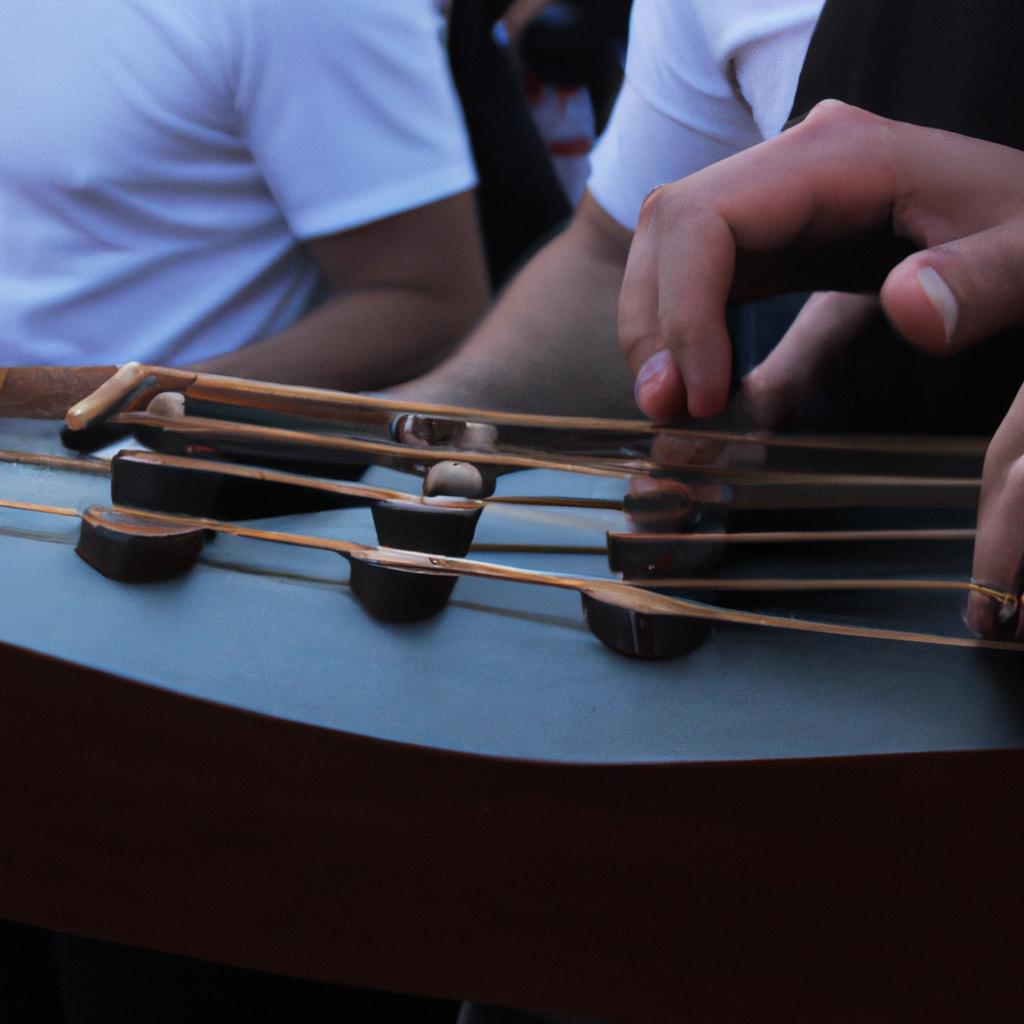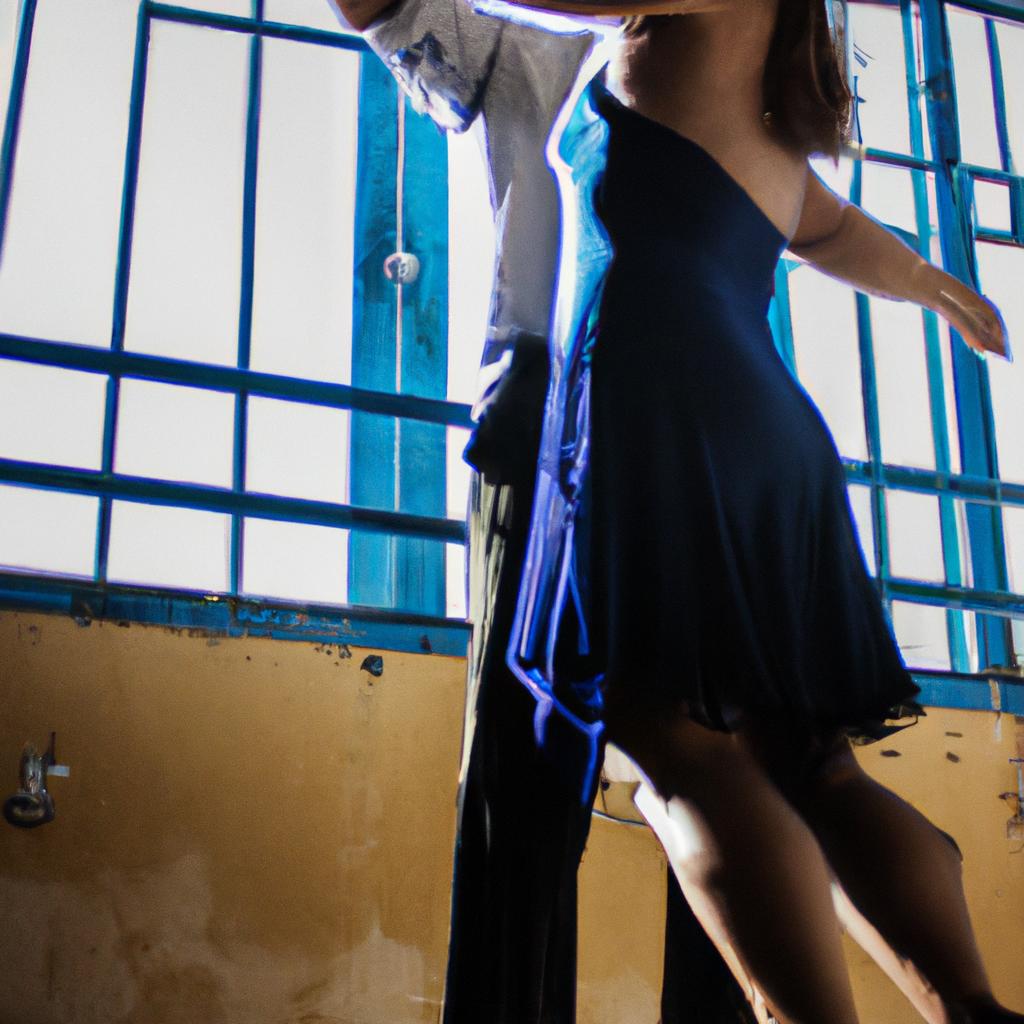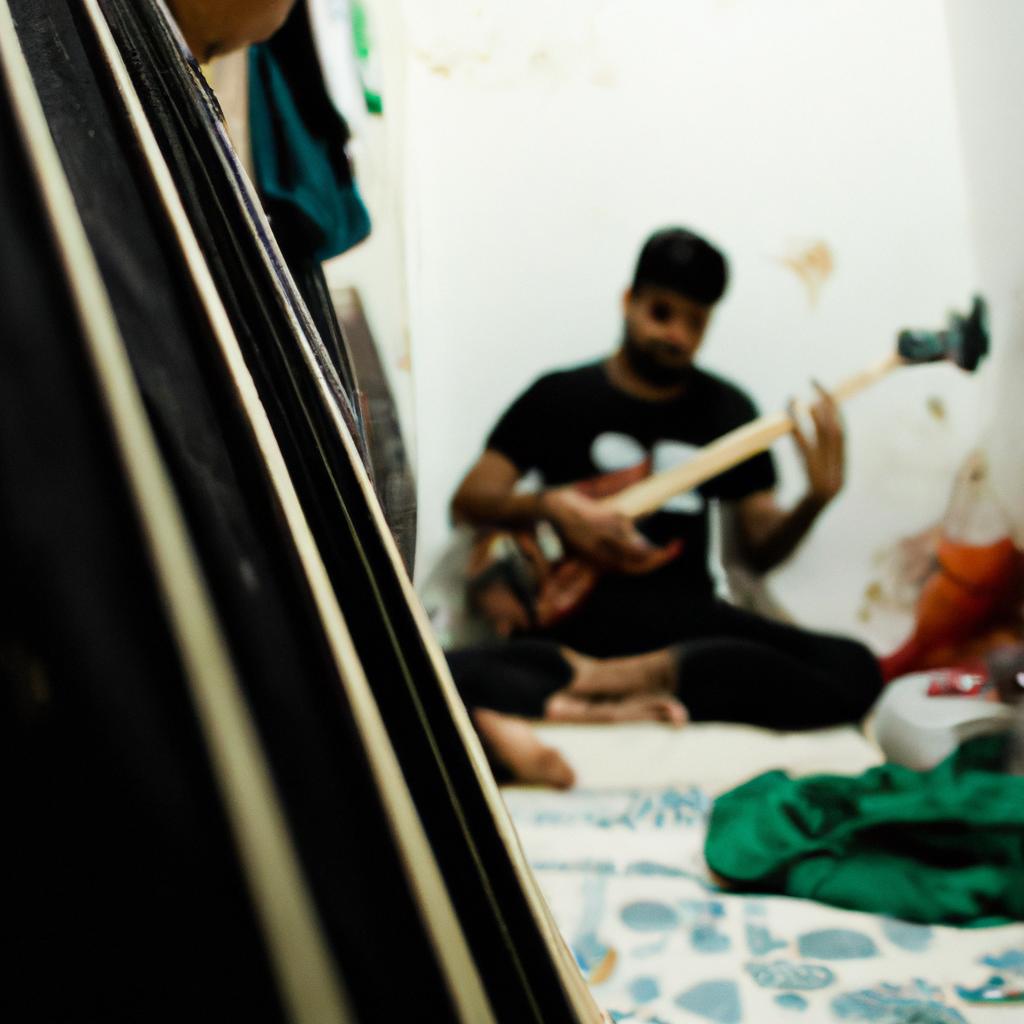Pizzicato, a distinctive technique commonly associated with string instruments such as the violin and cello, finds an unexpected yet captivating application within the realm of tango music. This unique instrumental approach involves plucking the strings instead of using a bow, resulting in a percussive and rhythmic sound that adds depth and complexity to the performance. Consider, for instance, a hypothetical scenario where a skilled tango musician deftly executes pizzicato on their violin during a live performance. As the audience becomes enraptured by the pulsating beat emanating from the instrument, they are drawn into an immersive musical experience that transcends traditional boundaries.
The exploration of pizzicato as a technique in tango music offers intriguing insights into both its historical development and contemporary applications. Originating in Argentina in the late 19th century, tango emerged as a vibrant musical genre characterized by its passionate melodies and expressive dance movements. In this context, employing pizzicato introduces new tonal possibilities that enhance the inherent rhythmicality of tango compositions. By investigating various aspects of pizzicato’s integration within this art form – including its technical execution, melodic variations, and improvisational potential – one can discern how it contributes to shaping the dynamic and evocative nature of tango music.
From a technical standpoint, the execution of pizzicato in tango requires precision and dexterity. The musician must pluck the strings with their fingers or thumb, carefully controlling the intensity and timing to achieve the desired rhythmic effect. This intricate manipulation of the instrument creates a distinctive percussive quality that complements the driving rhythms often found in tango compositions.
Moreover, pizzicato allows for melodic variations within tango music. By plucking individual strings or groups of strings, musicians can emphasize certain notes or create unique ornamentations that enhance the expressiveness of the melody. These embellishments add richness and depth to the overall musical texture, captivating listeners with their unexpected yet alluring tonalities.
Pizzicato also provides opportunities for improvisation in tango performances. Skilled musicians can use this technique to introduce spontaneous rhythmic patterns or explore new harmonic possibilities on-the-fly. This element of improvisation adds an exciting and unpredictable dimension to live performances, making each rendition of a tango piece a truly unique experience for both performer and audience.
In conclusion, pizzicato’s integration within tango music offers a fascinating exploration of its historical development and contemporary applications. Through its percussive sound, melodic variations, and improvisational potential, pizzicato contributes to shaping the vibrant and immersive nature of tango music. Whether experienced in intimate milongas or grand concert halls, this distinctive instrumental technique captivates listeners by adding complexity, emotion, and rhythmicality to this beloved genre.
What is Pizzicato?
What is Pizzicato?
Pizzicato, derived from the Italian word “pizzicare” meaning “to pluck,” is a distinctive technique used in playing stringed instruments. It involves using the fingers to pluck or snap the strings instead of using a bow. This technique adds a unique flavor and rhythmic texture to various musical genres, including tango.
To illustrate the impact of pizzicato on tango music, let us consider a hypothetical scenario. Imagine a passionate Argentine tango performance where the melancholic melody dances effortlessly through the air. Then suddenly, as if by sorcery, the violinist transitions into pizzicato, creating an energetic and vibrant atmosphere that pulsates with each note. The audience becomes captivated by this playful interplay between rhythm and melody, further enhancing their emotional connection to the music.
The essence of pizzicato lies not only in its sonic qualities but also in its ability to evoke emotions within listeners. Here are some aspects that contribute to its emotive power:
- Expressiveness: Pizzicato allows musicians to add nuance and expressiveness to their performances, conveying feelings such as joy, longing, or excitement.
- Rhythm: By emphasizing specific beats or syncopated patterns through plucking motions, pizzicato can create intricate rhythmic structures that enhance the overall groove and drive of tango music.
- Contrast: When juxtaposed with bowed sections or other instrumental techniques, pizzicato creates contrast and highlights certain musical moments effectively.
- Versatility: Pizzicato is versatile enough to be applied across different string instruments like violins, cellos, double basses, and guitars. Its adaptability makes it accessible for both solo performers and ensemble players.
| Emotive Aspects |
|---|
| Expressiveness |
| Rhythm |
| Contrast |
| Versatility |
In summary, pizzicato is a technique that adds depth and character to tango music. Its ability to evoke emotions through expressiveness, rhythmic variations, contrast, and versatility makes it an indispensable tool in the repertoire of stringed instrument players.
Transitioning into the subsequent section about “The Origin of Pizzicato,” we delve into the historical roots of this intriguing technique, tracing its development and influence throughout history.
The Origin of Pizzicato
Transitioning from the previous section discussing what pizzicato is, let us now delve into the origins of this unique technique. To illustrate its historical significance, consider a hypothetical scenario where a renowned tango musician encounters an instrument with broken strings just moments before a performance. In order to salvage the situation and maintain the rhythmic integrity of their music, they decide to pluck the remaining intact strings instead of using a bow.
The origin of pizzicato can be traced back to various cultures throughout history. However, it was not until the 17th century that it gained recognition in Western classical music as a distinct playing technique. During this time, composers began incorporating pizzicato passages within their compositions to add contrast and texture to their works.
To understand how pizzicato has evolved over time, here are some key points:
- Pizzicato markings: Composers indicate when pizzicato should be used through specific notation markings on sheet music. This allows musicians to accurately interpret when and how often they should pluck the strings.
- Variations in sound: The way in which an artist executes pizzicato greatly affects the timbre produced. From delicate finger motions producing soft notes to more forceful actions creating percussive sounds, each approach adds depth and character to the overall musical experience.
- Extended techniques: Over time, pizzicato has been explored beyond simple plucking. Musicians have developed innovative methods such as double-stopping (simultaneously plucking two or more strings) and left-hand pizzicato (plucking while simultaneously pressing down on a string).
- Expressive possibilities: Through subtle variations in pressure, speed, and articulation, musicians can convey emotions ranging from playfulness to melancholy through their execution of pizzicato phrases.
Table showcasing famous classical compositions utilizing Pizzicato:
| Composer | Composition | Notable Use of Pizzicato |
|---|---|---|
| Johann Strauss II | “An der schönen blauen Donau” (The Blue Danube) | The famous waltz features a memorable pizzicato section, creating a lighthearted and rhythmic atmosphere. |
| Pyotr Ilyich Tchaikovsky | Symphony No. 4 in F minor, Op. 36 | In the third movement of this symphony, Tchaikovsky employs pizzicato strings to create a playful and whimsical effect amidst the overall intensity of the piece. |
| Maurice Ravel | String Quartet in F major | Ravel showcases the versatility of pizzicato by incorporating it extensively throughout this string quartet, highlighting its percussive nature and vibrant sound. |
As we conclude our exploration into the origins of pizzicato, we can now move on to examining its role within classical music compositions. By understanding how this technique has been utilized by classical composers spanning different eras, we gain further insight into its significance as a musical tool.
[Transition sentence for next section: Pizzicato in Classical Music]
Pizzicato in Classical Music
Section H2: Pizzicato in Classical Music
The technique of pizzicato, originating from the Italian word “pizzicare” meaning to pluck or snap with the fingers, has found its way into various styles and genres of music. While we have explored its origins in a previous section, let us now delve into how pizzicato is utilized in classical music.
One notable example illustrating the use of pizzicato in classical compositions is Maurice Ravel’s “Boléro.” In this iconic piece, Ravel employs pizzicato strings to create a rhythmic ostinato that underpins the entire composition. The repetitive nature of the plucked notes adds a distinct flavor to the overall orchestration, enhancing the hypnotic effect for which “Boléro” is renowned.
When examining pizzicato within classical music, several key characteristics emerge:
- Expressive possibilities: Pizzicato allows composers and performers to explore unique ways of expressing emotions through their instruments. By plucking the strings instead of using a bow, musicians can produce contrasting tones that range from delicate and ethereal to bold and percussive.
- Textural variety: Incorporating pizzicato passages alongside bowed sections introduces textural diversity within an orchestral piece. This contrast not only captures listeners’ attention but also enriches the overall sonic tapestry by interweaving different timbres.
- Dynamic contrasts: Pizzicato lends itself well to creating dynamic shifts within a composition. By juxtaposing sections played with a bow against those executed with finger-plucked precision, composers can achieve striking variations in volume and intensity.
- Artistic innovation: Throughout history, many composers have experimented with unconventional techniques involving pizzicato. From Bartók’s use of col legno (striking the string with the wood of the bow) to Stravinsky’s exploration of simultaneous bowed and plucked passages, these innovations have pushed the boundaries of classical music.
The incorporation of pizzicato into classical compositions showcases its versatility as a technique capable of enhancing expressiveness and expanding the sonic palette. In our subsequent section on “Pizzicato in Popular Music,” we will explore how this unique instrumental technique has transcended traditional genres to become an integral part of contemporary musical landscapes.
Pizzicato in Popular Music
Pizzicato: The Tango Instrument Technique
Transitioning from the previous section that explored pizzicato in classical music, let us now delve into its application within popular music genres. To further comprehend the versatility of this technique, we will focus on its usage in tango music.
Imagine a dimly lit dance hall filled with couples swaying to the passionate rhythms of tango. As the sultry melodies unfold, you notice how the violinist deftly plucks at their instrument’s strings, creating an intimate and expressive sound. This demonstration highlights just one example of how pizzicato is employed to enhance the emotional depth of tango compositions.
To grasp the significance of pizzicato in tango music, consider the following aspects:
- Expressive storytelling: Pizzicato allows musicians to articulate intricate narratives through their instruments. By delicately plucking or forcefully snapping the strings, they can evoke emotions ranging from longing and melancholy to excitement and desire.
- Rhythmic complexity: In tango music, rhythm plays a pivotal role in driving dancers’ movements. Pizzicato adds another layer of rhythmic intricacy by introducing syncopation and contrasting accents. This dynamic interplay between bowing and plucking amplifies the pulsating energy inherent in tango compositions.
- Collaborative dialogue: Within an ensemble setting, pizzicato provides opportunities for musical conversations among various instruments. Violins engage in playful exchanges with bandoneons or guitars, engaging listeners through call-and-response patterns that mirror the sensuality often associated with tango dancing.
- Tonal variation: The timbre produced by pizzicato differs significantly from that generated by traditional bowed techniques. Its crisp attack and shorter sustain create a distinct tonal quality that complements other elements within a tango arrangement, contributing to its overall character.
The table below demonstrates some notable characteristics of pizzicato in comparison to its bowed counterpart, highlighting the unique emotional impact it imparts in tango music:
| Bowed Technique | Pizzicato Technique | |
|---|---|---|
| Sound Quality | Smooth and sustained | Crisp and percussive |
| Expressiveness | Elegantly lyrical | Emotionally intimate |
| Articulation | Legato bow strokes | Plucked or snapped strings |
| Rhythmic Effect | Fluid and flowing | Syncopated accents |
Transitioning seamlessly into our subsequent section about pizzicato in tango, we can explore how this technique intertwines with the passionate spirit of this genre. By examining specific compositions and notable performers, a deeper understanding of pizzicato’s role in tango music will emerge.
Pizzicato in Tango
From the previous section discussing the use of pizzicato in popular music, we now delve into its application within the tango genre. Pizzicato has long been an integral part of tango music, adding a distinctive flavor and rhythmic complexity to this passionate dance form. In exploring pizzicato in tango, we will examine its historical origins, technical execution, and stylistic variations.
To illustrate the significance of pizzicato in tango, let us consider a hypothetical scenario where a renowned tango ensemble is performing at a milonga (a traditional tango social gathering). As the dancers gracefully glide across the floor, their movements are intricately intertwined with the vibrant sounds emanating from the musicians’ instruments. Among them, the double bass player stands out as they skillfully pluck the strings using various techniques of pizzicato: quick staccatos that accentuate each beat and lyrical melodies that evoke deep emotions.
When examining pizzicato’s role in tango music, several key aspects come to light:
-
Rhythmic Drive:
- The percussive nature of pizzicato provides a strong rhythmic foundation for dancers.
- Its syncopated patterns interweave seamlessly with other instruments to create lively polyrhythms.
- Example bullet point:
- Energetic pulsation
- Infectious groove
- Dynamic interplay
- Syncopated rhythms
-
Expressive Melodies:
- Pizzicato allows for expressive melodic lines that can convey melancholic or exuberant feelings.
- The range of tonal possibilities enables musicians to emulate human vocalizations through their instrument.
- Example table:
| Emotions conveyed by pizzicato | Descriptors |
|---|---|
| Longing | Soulful |
| Passion | Fiery |
| Joy | Playful |
| Sadness | Melancholic |
- Ornamental Flourishes:
- Pizzicato techniques such as tremolo and glissando add ornamental flourishes to tango music.
- These embellishments enhance the overall virtuosity of the performance, captivating listeners’ attention.
In conclusion, pizzicato plays a vital role in shaping the distinctive sound of tango music. Through its rhythmic drive, expressive melodies, and ornamental flourishes, it creates an immersive musical experience that resonates deeply with both dancers and audience members. Building upon this exploration of pizzicato’s use in tango, we will now delve into specific techniques and styles within this genre.
With our understanding of how pizzicato contributes to the essence of tango firmly established, let us now turn our focus towards exploring various pizzicato techniques and styles commonly employed by musicians in this vibrant dance form.
Pizzicato Techniques and Styles
Transitioning smoothly from the previous section on “Pizzicato in Tango,” let us now delve into a deeper exploration of pizzicato techniques and styles used in this captivating genre. Understanding these nuances is crucial for musicians seeking to master the art of tango performance.
One example that illustrates the versatility of pizzicato within tango music is the work of renowned Argentine composer Ástor Piazzolla. In his composition “Libertango,” Piazzolla seamlessly integrates various pizzicato techniques, such as staccato plucks and rapid arpeggios, to create an intense and passionate atmosphere. This exemplifies how pizzicato can be manipulated to convey different emotions and enhance the overall musical experience.
To fully grasp the significance of pizzicato in tango, it is essential to explore its distinctive characteristics and stylistic elements. Here are some key aspects:
- Rhythmic Drive: Pizzicato in tango often features vigorous rhythmic patterns that drive the dance forward, creating a sense of urgency and energy.
- Expressive Melodies: Through expressive bowing techniques or precise finger placements, pizzicato allows performers to articulate melodic lines with emotional depth, adding richness to the music.
- Interaction with Other Instruments: Pizzicato interacts dynamically with other instruments in the ensemble, engaging in lively dialogues and enhancing the interplay between different voices.
- Ornamentation: Similar to ornamentation found in baroque music, pizzicato embellishments like trills, mordents, or glissandos add flair and individuality to performances.
To illustrate further how these elements come together harmoniously within tango compositions employing pizzicato technique, consider the following table showcasing excerpts from notable pieces:
| Composition | Composer | Notable Pizzicato Technique |
|---|---|---|
| “La Cumparsita” | Gerardo Matos | Syncopated pizzicato rhythms |
| Rodríguez | ||
| “Adiós Nonino” | Ástor Piazzolla | Ornamented pizzicato melodies |
| “El Choclo” | Ángel Villoldo | Intertwined arpeggios |
| and staccato plucks |
Through these examples, we can perceive the emotional impact that pizzicato techniques can have on tango music. The rhythmic drive, expressive melodies, interaction with other instruments, and ornamentation all contribute to the unique character of this genre.
Ultimately, exploring different pizzicato techniques in tango allows performers to unlock a wide range of musical possibilities. By incorporating rhythmic vitality and expressive finesse, musicians can captivate audiences with passionate performances that embody the essence of this enchanting dance form.




